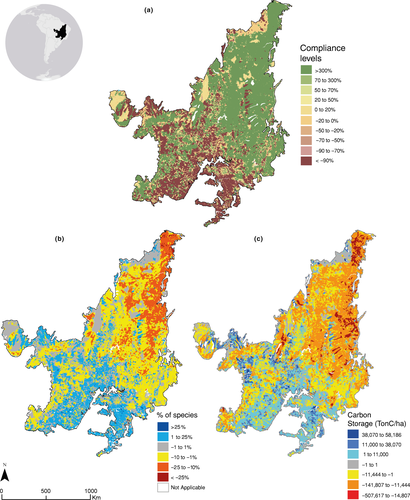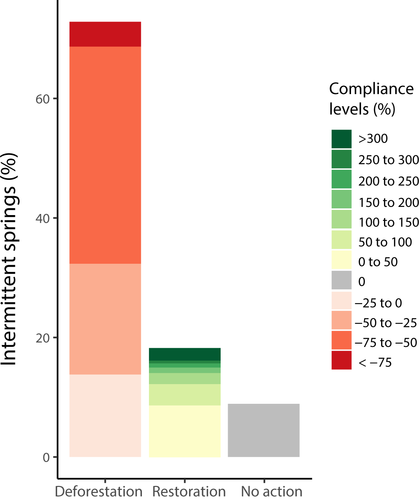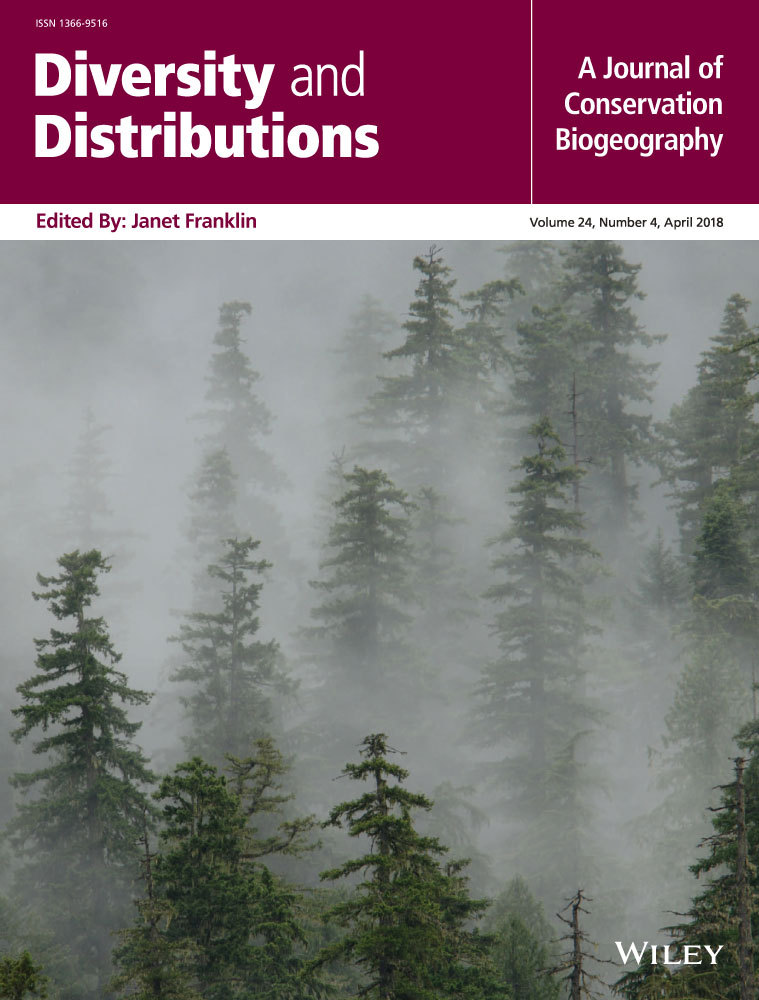Compliance to Brazil's Forest Code will not protect biodiversity and ecosystem services
Abstract
In striking contrast to heartening events in the adjacent Amazon, Brazil's Cerrado biome has seen continued deforestation over the past decade. Though approved in 2012, no study evaluated the impacts of new Brazilian Forest Code (FC) revision on biodiversity and ecosystem services. Here, we report the first assessment of the likely loss and gain in biodiversity and ecosystem services expected if the FC is properly enforced across 200 million hectares of the Cerrado. We also discuss the challenges associated to compliance with the law and present opportunities for conservation. Establishing restoration programmes in private properties with currently less native vegetation than required by the FC could create habitat for 25% more threatened species than now found in these places and could also increase water security and carbon stock in 56.6 MtC. More important, trading environmental reserve quotas coupled with the strategic expansion of protected areas on private and public land could definitely rescue the Cerrado from the brink.
INTRODUCTION
Brazil's environmental legislation is currently under siege by agribusiness lobby and interest to expedite the environmental licensing for infrastructure development (Fearnside, 2016). In 2012, the Congress approved a controversial revision to Brazil's Forest Code (FC), which regulates land use on private properties. Although the impacts of FC revision on vegetation have been addressed (Brancalion et al., 2016; Soares-filho et al., 2014; Strassburg et al., 2017), no study evaluated its impacts on biodiversity. We report the first assessment of losses and gains in biodiversity and ecosystem services (ES) expected if the FC is properly enforced. We project high losses of ES and biodiversity and suggest solutions to address such a dismal scenario.
We focused our analyses on 200 million hectares (Mha) of tropical savanna within the Cerrado, as an example of its likely impacts nationwide. The Cerrado is key for the maintenance of Brazil's biodiversity and the provision of ecosystem services (Overbeck et al., 2015). However, it is also the most vulnerable savanna in the world: 46% of its native vegetation cover has been lost (88 Mha) and just 19.8% remains undisturbed (Strassburg et al., 2017). Roughly, 40% of remaining native vegetation can be legally converted—FC requires that only 20% of private lands be set aside for conservation (Soares-filho et al., 2014; Strassburg et al., 2017). Additionally, weak protection (only 7.5% of the Cerrado is covered by protected areas) puts its huge biodiversity and ecosystem services in jeopardy.
We used data from Brazil's 2014 Red Lists of threatened plant and animal species (totalling 1029 threatened species), carbon biomass and the distribution of intermittent water springs (that are no longer protected by the new FC and represent almost 40% of all springs within the Cerrado), to estimate loss and gains in biodiversity and ecosystem services from likely deforestation or restoration on private lands as regulated by the FC (Table S1). We found that 26% of the Cerrado areas are currently in debt with existing legislation having less native vegetation than required by the FC (Figure 1a). This situation implies that nearly 5 Mha of deforested land would need to be restored (Table S2). Northern Cerrado holds surplus of vegetation, meaning that 39 Mha of native vegetation could be legally deforested because properties have more native vegetation than required by the FC. This figure alone is three times larger than Brazil's national policy to restore/reforest 12 Mha as part of its Nationally Determined Contribution to Paris Treaty (MMA 2017).

Such potential legal deforestation, if realized, would entail an unprecedented species extinction crisis. Our calculations based on species–area relationships (see Supporting Information) indicate that 51.6% of private lands might lose at least one threatened species; 374 (1%) of those might lose up to 221 (Figure 1b and Figure S1). Most of the threatened plant species occur only in the Cerrado and thus are likely to go extinct (Strassburg et al., 2017). Loss would be higher in the north and in the southeast, areas in contact with the Brazilian Atlantic Forest.
Compliance to FC also impacts nature's contribution to people, such as climate stability and water availability. If all legal deforestation were realized, nearly 50% of private lands would lose more than one thousand tons of carbon per hectare (Figure 1c and Figure S2). Total loss of carbon stock in the Cerrado amounts to 385 million tons of carbon (MtC, Table S2), which is almost the double of the stock secured in all currently established protected areas of the biome (Medeiros & Young, 2011). Loss of vegetation would also threat water supply to urban populations in the Cerrado (currently >29 million people; IBGE 2010) and elsewhere. Most intermittent springs (72.8%) lie in areas with current surplus of vegetation. Further, 18.3% of intermittent springs lie currently in lands in need for restoration (Figure 2).

The picture we found is dismal and will likely preclude the Brazilian society to achieve its international environmental and climate mitigation commitments. In particular, the Aichi Biodiversity Targets 5 (deforestation close to zero), 7 (biodiversity conserved in areas under agriculture), 12 (threatened species away from extinction) and 15 (at least 15% of degraded lands restored) would become impossible to achieve by 2020. This situation reflects a common practice in Brazil in which there is an enormous mismatch between international agreements and in-house conservation decisions and policymaking (Loyola, 2014).
Over the past years, Brazil has witnessed a coordinated systematic attack to its environmental legislation (see discussions in Ferreira et al., 2014; Loyola, 2014; Fearnside, 2016; Azevedo-Santos et al., 2017). The makeup of Congress is dominated by powerful rural lobby (Fearnside, 2016). The political instability that Brazil is facing in the last years threats the reversal of environmental progress. Under pressure to approve other controversial bills and emends (Azevedo-Santos et al., 2017), the Congress often rely on sudden approval of environmentally damaging measures (e.g., undermining the national environmental licensing system and the revision of the Mining Code) in exchange of support by the rural lobby to other controversial political issues, such as the welfare reform.
There is no easy solution to avert loss of biodiversity and ecosystem services in the Cerrado, but enforcement of restoration on private lands below the FC compliance is paramount (Strassburg et al., 2017). Restoring the required 4.7 Mha of these lands would increase carbon stock in 56.6 MtC and would create new habitat leading to an increase in up to >25% the number of species in private lands currently in debt, according to our calculations (Figure 1b,c, Table S2). It would also increase water security and benefits from 18.3% of intermittent springs that are located in heavily impacted private lands where restoration is demanded (Figure 2).
Due to deforestation and fires, the Cerrado is a major contributor to national emissions, and its protected areas play a pivotal role in mitigating climate change effects in Brazil. Recent studies showed that the network of protected areas established in the Cerrado was effective in avoiding deforestation in areas that would have been converted if not protected (Carranza, Balmford, Kapos, & Manica, 2014). However, almost 73% of all intermittent springs in Cerrado are located on lands that could be legally deforested. Intermittent springs and rivers provide ecosystem services and support a diverse biota nearly just like any other water body; however, they are neglected by society and have attracted less attention than perennial rivers (Datry et al., 2017). In a biome that contributes to 43% of all Brazilian freshwater outside of the Amazon, increasing protection and fostering large-scale restoration programmes are essential to guarantee water security (Strassburg et al., 2017).
A cuation must be made, however: the Cerrado is not a forest-dominated ecosystem. Therefore, proposals of large-scale afforestation for the region have been rejected by the scientific community (Overbeck et al., 2015; Veldman et al., 2015). A sustainable alternative scenario that reconciles agricultural expansion, conservation and restoration is within reach, nevertheless. There is no need of further conversion of native vegetation to enhance crop and beef production in Brazil. A right mix of current policies would suffice to achieve such sustainable scenario (Strassburg et al., 2017). These policies involve effective and comprehensive implementation of the FC by federal and state government, land reform, continuity of satellite-based monitoring systems, implementation of the low-carbon agriculture plan in the Cerrado, policies for the conservation of threatened species and initiatives from the private sector such as international certification standards and boycotts of agricultural products grown in recently deforested or high-biodiversity areas, such as the soy moratorium (Soares-filho et al., 2014; Strassburg et al., 2017).
The new FC introduced the Environmental Reserve Quota (Portuguese acronym, CRA) as a new mechanism that allows the vegetation debts of one property to be offset with the surpluses of another property in the same biome (Brancalion et al., 2016). CRA can be a new form of fostering payment for ecosystem services programs (Soares-Filho et al., 2016), and it is estimated to have better economic and conservation outcomes when compared to a scenario of full compliance at the property (Veldman et al., 2015). Although CRA trading will not be enough to prevent legal deforestation in the Cerrado, it is crucial that states and the union counterbalance the FC debts in already established priority areas for conservation, enhancing the effectiveness of protection.
Nevertheless, high costs of proactive restoration (recently estimated in US$ 1,000–5,000 ha−1) and unclear regulations about what qualifies an area as restored after the allotted 20-year recovery period make restoration a hard choice to most landowners (Bernasconi, Blumentrath, Barton, Rusch, & Romeiro, 2016). Further, restoration carries uncertainties. First, choice of restoration method in the Cerrado depends on the history of land use in the area. Natural regeneration, assisted or not, is successful only where the subterranean structures of the Cerrado plant species were not destroyed, what happens in most agriculture models (Pellizzaro et al., 2017). Currently, seeding and topsoil methods are pointed out as the best cost-effective methods, with much lower costs than planting nursery-raised seedlings, but they also lead to some problems, like species dominance (Pellizzaro et al., 2017; Sampaio et al., 2015). Further, there is no guarantee that restored areas will recover the same species, their ecological roles and deliver ecosystem services existing in the past; if they do, there is a huge time-lag between the implementation and the perceived outcomes arising from restoration. Hence, averting deforestation in properties holding vegetation surplus is a better strategy for conservation in the short term as an area of native vegetation remnants is often richer in biodiversity and has higher conservation value than a new planted forest. CRA has as important role to play in this strategy. Given that CRA supply is higher than its current demand (Soares-Filho et al., 2016), CRA market is affordable to most landowners and should be fostered by the government, private sector and the civil society.
More than ever, Brazil needs to decide whether to develop sustainably or in traditional ways that endanger its natural capital (Ferreira et al., 2014; Loyola, 2014). It already has legal (e.g., Plan for Prevention and Control of Deforestation in the Cerrado—PPCerrado; Land Reform policy) and market instruments in place to allow for a green and socially just transition that will safeguard the existence of species and ecosystems in the most biologically diverse country in the world guaranteeing food, water and all other nature's contribution to >200 million people that depend on nature to thrive. No form of development is sustained in the long run based on highly exploitative activities, excluding people and the environment. We urge our society, national policymakers and international stakeholders to engage in favour of effective environmental legislation that supports countrywide welfare and sustainable development in all its dimensions.
ACKNOWLEDGEMENTS
A Portuguese version of this work may be found online in the supporting information tab for this article. RL thank CNPq (grant 308532/2014-7) and O Boticário Group Foundation for Nature Protection (grant PROG_0008_2013) for funding his research. RRSV, BRR, LPS, FMR, LM thank CAPES for supporting their work. This manuscript is a contribution of the Brazilian Network on Global Climate Change Research funded by CNPq (grant 437167/2016-0) and FINEP (grant 01.13.0353.00) and of the INCT in Ecology, Evolution and Biodiversity Conservation founded by MCTIC/CNPq/FAPEG (grant 465610/2014-5). We also thank Daniel Zacarias and Edith Esparza for helping with data analysis and Thomas Brooks and Fabio Scarano for comments on the manuscript.
REFERENCES
BIOSKETCH
Authors are members of the Conservation Biogeography Lab, which is focused on delivering scientifically validated evidence, analysis and synthesis to support conservation decision and policymaking, especially in Brazil.
Author contributions: R.R.S.V. and R.L. conceived the study; R.R.S.V., B.R.R., F.B., N.M., L.P.S., F.M.R., L.M0 compiled and analysed data; B.S.-F. developed land use models; R.L. wrote the first draft; all authors contributed to writing.




